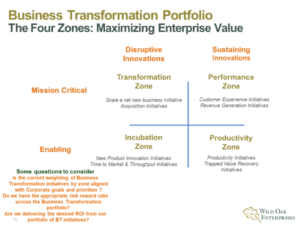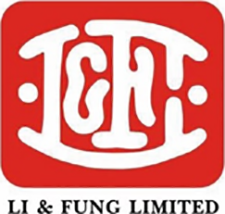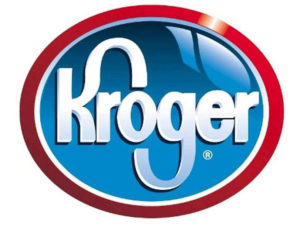
October 30, 2019
In the digital world,
Digital Transformation is an oxymoron

Last year, a McKinsey study documented that companies spent more than $1.3 trillion on digital transformations 70% of which failed to reach their desired outcomes which means that over $900 billion went to waste. The primary reason for these failures is that companies thought the goal was to develop and deliver new digital technologies not fundamentally transform the companies’ operating and business models. To get the desired outcomes, companies must define the goal as business transformation not digital transformation.
What’s Business Transformation?

Business transformation is a fundamental change in how a company delivers value to its customers, employees, supply chain partners and other key stakeholders. It spans a portfolio of initiatives:
- To improve the productivity and efficiency of its cost centers and support functions
- To modernize its operating model to deliver more compelling customer experiences
- To increase its ability to develop and deliver new innovations that leverage digital technology
- To transform its business model to compete as a digital enterprise
As my colleague and friend Jon Low puts it, “Deciding to introduce a new technology before determining how the enterprise’s organization, people and processes need to change – and how technology will impact that change – is putting the digital cart before the horse.”
Some core questions to start the business transformation dialogue

The successful execution of a business transformation is the greatest leadership challenge senior executives have faced in several decades. Not only does it demand rethinking long held beliefs about what has made the company successful in the past but calls into question what are the fundamental changes the company has to make to compete as a digital enterprise in the future. As such, any business transformation initiative must start with the CEO and the Board agreeing on what the ultimate outcome needs to be.
As I’ve written is several earlier blogs, here are some core questions to get the business transformation dialogue started:
- How long can the company’s current business model deliver its desired business growth goals and financial results?
- How sustainable are the company’s revenues, margins and profits?
- How vulnerable is the company’s business model to being digitally disrupted?
- How quickly could the company respond to this digital disruption?
- How well can the company leverage digital technology for increased competitive advantage?
- How robust is the company’s digital technology pipeline?
- How open is the company’s culture to changing the way it does business?
- How capable is the company at competing as a digital enterprise?
As my brother, Geoffrey Moore said in his book Escape Velocity, “freeing your company’s future from the pull of its past” will be the differentiating factor between success and failure for companies of all sizes across all industries. At its essence, business transformation is all about freeing a company’s future from the pull of its past.
Use the 4 Zones Model to organize & prioritize your portfolio of business transformations
Successful business transformations are driven by a unified aspiration for a higher level of performance across the entire organization and include all levers of value creation. Segmenting the portfolio of business transformation initiatives by zone provides a very effective governance structure, as well as, a way to prioritize resource and budget allocation decisions to fund their implementation as shown on the slide below:

Productivity Zone business transformation is about transforming your shared services model by redeploying scarce resources and budget away from low value run the business functions to high value change the business functions. This also requires a shift in focus from technical & functional outcomes to business outcomes.

Li & Fung, a Hong Kong supply chain management company, identified three critical business outcomes: reduce production lead times; increase speed-to-market; and improve the use of data in its global supply chain. Armed with those goals, IT embraced virtual design technology that reduced time from design to sample by 50%. They also installed a real-time data tracking management system to increase production efficiency and built Total Sourcing, a digital platform that integrates customers and vendors which increased the company’s working capital efficiency by $200 million.
Companies can also create value in this zone by automating processes and systems thereby freeing up their employees from low value clerical tasks to do high value business transformation initiatives.
Performance Zone business transformation is about transforming your operating model to enable the company’s business units to better engage with its customers, supply chain partners and other key stakeholders. By contributing directly to creating valuable and enduring customer experiences, the company can demonstrate its ability to leverage digital technology to deliver increased revenues, margins, and profits.

In 2001, when Doug Baker Jr. became CEO, Ecolab was an 80-year old company growing 10% annually selling industrial cleaners and food safety services. As he said then, “our strategic plan was to sell more of what we had.” Baker had bolder growth ambitions for the firm which came from him talking with customers who expressed their great concerns about future access to clean water.
In 2011, Ecolab had a $12 million market cap when it acquired Nalco, a water technology company. The combined company is now one of the world’s leading suppliers of hardware, software and chemistry that helps manufacturers and service firms use water more efficiently. The primary metric that drives the companies performance goals is how much water its customers save annually which now stands at 188 billion gallons against a 2030 target of 300 billion gallons. The market has also rewarded Ecolab’s performance with a current market cap of $55 billion.
Incubation Zone business transformation is about transforming your business innovation model through identifying, testing and validating next generation product, service and business ideas and leveraging digital technology enabled innovation to deploy them. Utilizing Agile, Lean and DevOps processes will allow you to significantly increase speed to market and time to value for all test and learn initiatives.

Kroger has established a stand alone business unit called Sunrise Technology to drive multiple business transformation initiatives with the mind of a startup. Sunrise’s remit is to “think about the business problems and opportunities differently” and move at a much faster pace than the established enterprise.
Transformation Zone business transformation is about transforming your business model by launching and scaling a material net new line of business or pivoting from the current business model to a new digitally enabled business model. It also serves as a way to evaluate the onboarding of new strategic partners or acquisitions and determining how much value additional technology resources and investments will bring to the company.

In 2013, Netflix CEO Reed Hastings launched the company on a business transformation from just distributing content digitally to become a leading producer of original content that could win Emmys and Oscars. He acknowledged that the company could not compete with the breadth and scale of Comcast, Sky, Amazon, Apple, Microsoft, Sony, or Google but it could become a leader in world class content. In the six years since he unveiled this new purpose, the company’s revenue has tripled, its profits have multiplied 32-fold and its stock CAGR has increased 57% annually vs. 11% for the S&P 500.


